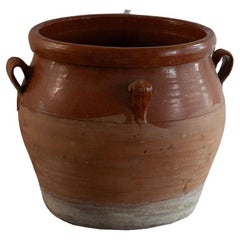4 Handle Ceramic Pot
Mid-20th Century French French Provincial Vases
Ceramic, Clay, Terracotta
People Also Browsed
Mid-20th Century French French Provincial Pottery
Stoneware
Antique 1740s Spanish Primitive Benches
Wood
Antique Late 19th Century Spanish Baroque Cupboards
Iron
Antique 19th Century Spanish Urns
Terracotta
Early 20th Century French Rococo Revival Decorative Dishes and Vide-Poche
Ceramic, Majolica
Late 20th Century Spanish Spanish Colonial Console Tables
Iron
Vintage 1950s French Mid-Century Modern Side Tables
Leather
17th Century Baroque Portrait Paintings
Oil, Canvas
Antique Late 19th Century French Aubusson Tapestries
Wool, Cotton
Antique 19th Century English Other Planters and Jardinieres
Earthenware, Terracotta
Antique 19th Century French French Provincial Jars
Pottery
Antique 19th Century French Picture Frames
Wood
Late 20th Century European French Provincial Vases
Ceramic, Clay, Terracotta
Vintage 1950s Austrian Mid-Century Modern Wall Lights and Sconces
Brass
Vintage 1930s Spanish Planters and Jardinieres
Terracotta
Antique 17th Century Chinese Ceramics
Porcelain
4 Handle Ceramic Pot For Sale on 1stDibs
How Much is a 4 Handle Ceramic Pot?
A Close Look at French-provincial Furniture
Removed from the fashions of the court, French Provincial style developed in the provinces of the country, such as Provence, Normandy, the Loire Valley and Bordeaux. Dating to the 17th and 18th centuries, French Provincial furniture was not as ostentatious as the designs being produced for the royal palaces, but elegant S-shape cabriole legs and ornate carvings elevated the sturdy chairs, sofas, tables and bedroom furniture intended for everyday use.
Although it varies by region, antique French Provincial furniture is unified by solid construction and an artisanal attention to design. While this furniture often followed the metropolitan trends — including the Rococo or neoclassical aesthetics of Louis XIV, Louis XV and Louis XVI — since it was produced in the French countryside it was more subdued with nods to its rustic settings.
Local materials like fruitwoods, oak, beech and walnut were used to construct large French Provincial armoires for storage and comfortable armchairs with rush-woven seats. Wrought-iron elements and carvings like floral details and scallop patterns were common as ornamentation. Furniture was frequently painted white or other muted colors that coordinated with gilt and would acquire a patina of age over time. Other wood was just stained with vibrant fabric such as toile de Jouy, which sometimes depicted pastoral scenes, adding color as upholstery.
The style arrived in the United States after World War I, with soldiers returning home wanting furniture like what they had seen in the rural homes and castles of France. In Grand Rapids, Michigan, designer John Widdicomb split from his family business, the Widdicomb Furniture Company, and had been focusing on Louis XV– and French Provincial–style furnishings since the early 1900s. Other American manufacturers such as Baker, Drexel, Henredon and Thomasville also responded to demand. Today antique French Provincial pieces and reproductions continue to be popular.
Find a collection of antique French Provincial dining tables, seating, decorative objects and other furniture on 1stDibs.
Finding the Right Vases for You
Whether it’s a Chinese Han dynasty glazed ceramic wine vessel, a work of Murano glass or a hand-painted Scandinavian modern stoneware piece, a fine vase brings a piece of history into your space as much as it adds a sophisticated dynamic.
Like sculptures or paintings, antique and vintage vases are considered works of fine art. Once offered as tributes to ancient rulers, vases continue to be gifted to heads of state today. Over time, decorative porcelain vases have become family heirlooms to be displayed prominently in our homes — loved pieces treasured from generation to generation.
The functional value of vases is well known. They were traditionally utilized as vessels for carrying dry goods or liquids, so some have handles and feature an opening at the top (where they flare back out). While artists have explored wildly sculptural alternatives over time, the most conventional vase shape is characterized by a bulbous base and a body with shoulders where the form curves inward.
Owing to their intrinsic functionality, vases are quite possibly versatile in ways few other art forms can match. They’re typically taller than they are wide. Some have a neck that offers height and is ideal for the stems of cut flowers. To pair with your mid-century modern decor, the right vase will be an elegant receptacle for leafy snake plants on your teak dining table, or, in the case of welcoming guests on your doorstep, a large ceramic floor vase for long tree branches or sticks — perhaps one crafted in the Art Nouveau style — works wonders.
Interior designers include vases of every type, size and style in their projects — be the canvas indoors or outdoors — often introducing a splash of color and a range of textures to an entryway or merely calling attention to nature’s asymmetries by bringing more organically shaped decorative objects into a home.
On 1stDibs, you can browse our collection of vases by material, including ceramic, glass, porcelain and more. Sizes range from tiny bud vases to massive statement pieces and every size in between.
